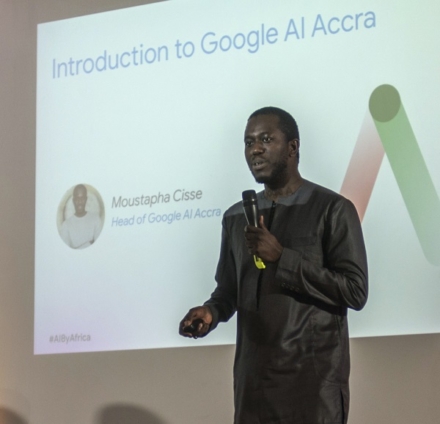In 2018, global technology giant, Google, opened its first Artificial Intelligence (AI) research center in Africa. The lucky host country? Ghana. A country whose new leadership was ratcheting up long proclaimed hopes of making the country: “the gateway to Africa”.
The tech giant’s decision to choose Ghana as the home of its AI hub in Africa came on the back of a much-publicized trip by the country’s Vice President to Silicon Valley, and was naturally seen as one of the fruits of highly successful economic diplomacy moves by the new government.
Three years later, Twitter also decided to choose Ghana for its “Africa HQ”.
Though Ghana has had some false starts in its perennial quest to position itself as the continent’s tech hub, the Hope City affair being merely one example, these high-profile seeming endorsements clearly signaled a step-change in the level of seriousness.
Linking intimately with the “Ghana Beyond Aid” agenda (the country’s now seemingly aborted plan to “graduate” from international development aid) and the “Digitalisation agenda” championed by the Vice President, the “hub” strategy was placed in pole position at the top of the country’s engagement with the World Bank, as the extract below from the Bank’s country diagnostic shows.
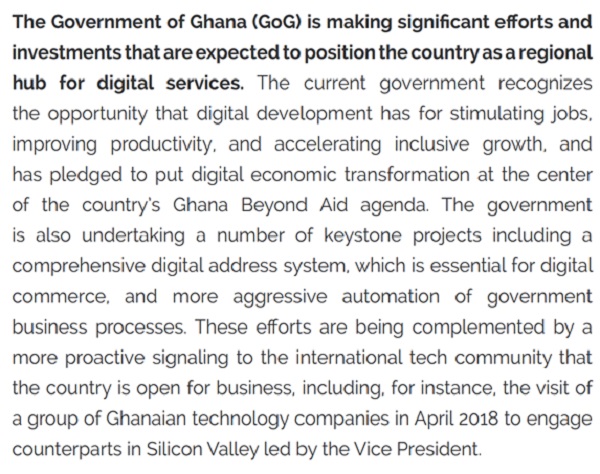
In other essays, this author has expressed his reservations about how the digitalisation vision has been executed so far. In this brief note, the aim is to quickly, and at a very high level, update readers on the hub strategy specifically using the Google AI experience as a micro case study. The analysis shall be based primarily on public disclosures made by Google’s executives working on the project.
The Google AI center in Accra has so far focused on, or engaged around, six main areas of exploration:
- Spatial analysis, with a focus on the built environment,
- Hydrological modeling,
- Insect pest swarm modeling,
- Maternal and reproductive health
- Speech disabilities, and
- Primary school reading skills
It is fair to assume that a key reason why an African country, or any country for that matter, would aim to attract global technology companies to invest in their country, especially as part of a “regional hub” strategy, is the building of an ecosystem for nurturing capabilities that can, in turn, be harnessed to solve national challenges, and better exploit available opportunities. A secondary objective is to turn the country into a platform for solving regional problems and exporting solutions to neighbouring countries.
A sound question then arises as to whether Ghana has been able to align its national policy priorities with those of Google in the four years since the latter set up shop in the country.
From what can be seen so far that work is still very much outstanding, as should be evident by examining five top Google focus areas in Ghana a bit more closely.
Geospatial
Ghana’s biggest priority in the geospatial space right now is bolstering its digital address system for development purposes. The government is keen to locate people where they stay and work for purposes of service delivery, national security, financial services KYC and, obviously, civil identification.
So much so that it sets up a “digital addressing system” – GhanaPostGPS – that has so far, according to the government, seen 7.5 million individual physical structures geo-tagged. So far, there have been about 1.4 million downloads across the various app stores, suggesting active installations of less than one million.
Most independent analysts who have studied the system describe it as an unmitigated failure, or at best a serious disappointment. Enterprise plug-ins are still unavailable 6 years after launch and virtually no e-commerce or digital service integrating it into their operations. It is at this point completely unclear what problem exactly GhanaPostGPS is solving, vindicating all the earlier scepticism about the approach.
The good thing is that the government itself, albeit belatedly, recognises the lacklustre results and has made overtures to Google for some kind of tight integration.
One would therefore think that with a Google AI Center in the country working on geo-spatial stuff, this would be one of the prime areas for collaboration. Alas, no. Google’s work in Ghana in this context has strictly focused on improving its Open Buildings dataset.
The primary goal of the entire effort is to make it easier for software systems to scan satellite imagery and quickly scope out buildings and their layout. Whilst this is important work (some researchers, for example, are using the data to project urban growth in Africa), it is very early-stage basic research that requires considerable investment in applied development for any sort of socioeconomic impact. Unfortunately, there has been no uptake so far for the outputs among any of Ghana’s main planning agencies, and, obviously, no derivative civil or business services.
Hydrological Modelling
The most topical issue, outside the rough and tumble of political life, in Ghana these past few weeks has been the disastrous way in which a raft of agencies in Ghana handled the “controlled spillage” of water from the country’s biggest hydroelectric dam. Despite claimed simulation successes, the exercise ended up displacing thousands from their homes and livelihoods.
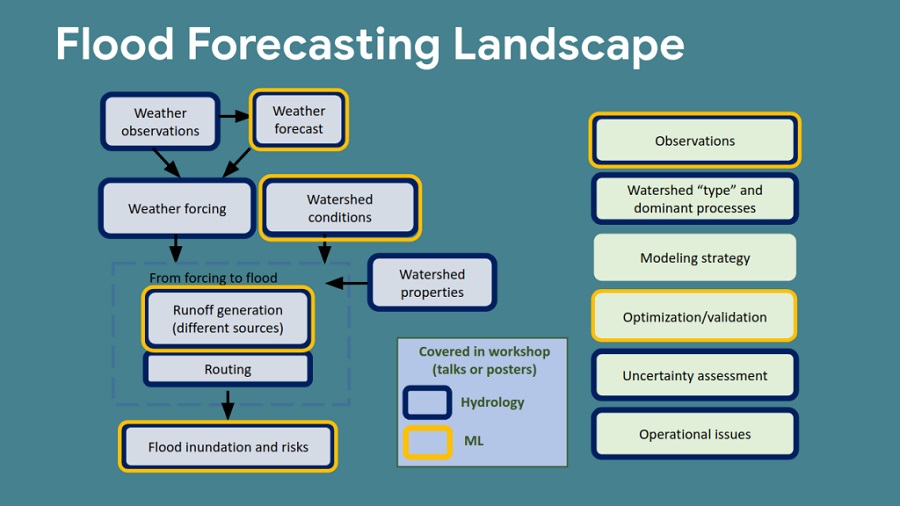
Source: Google Research
Just as the horrors of the Akosombo spillage start to abate, another perennial “controlled spillage” mess, the Kompienga and Bagre Dam overflow, is reported to be imminent.
Regular flooding in Ghana’s capital, Accra, is the stuff of legends.
It doesn’t take genius to link the need for better forecasting, spatial planning, and effective simulations in Ghana’s flooding management context to Google’s work on its Flood Hub.
Yet, this author’s detailed analysis of various outputs from Google’s “floodcasting” work so far has revealed an insignificant footprint of Ghanaian involvement, engagement, and results. Only broad weather pattern information in Flood Hub touches Ghana, the same kind of information obtainable from other weather data sources.
Insect Pest Swarm Modelling
Google’s work in this area focuses heavily on predicting locust outbreaks, a kind of pest invasion in which billions of the insects converge and descend upon a geographical area to wreak vegetational havoc.
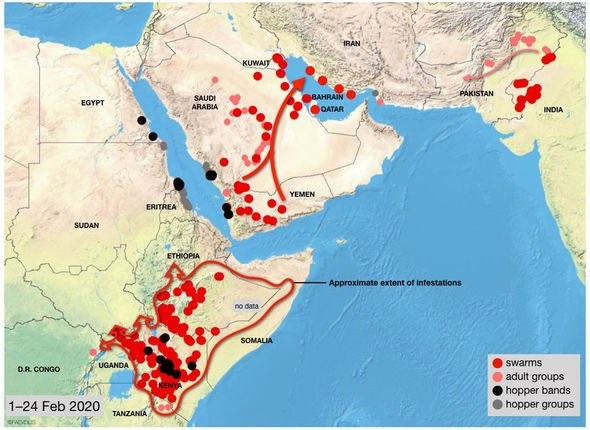
Source: Sebastian Kettley (Daily Express)
Locust invasions are highly blamed for food security challenges in East Africa and elsewhere. In West Africa, on the other hand, the last time locust plagues were a major link in food systems collapse was in the 1940s.
In Ghana, the insect pests of the greatest economic significance are mirids that attack cocoa farms, as any researcher in the space would tell you. Yet, farmers’ knowledge about these pernicious insects are heavily constrained by weak extension services.
AI systems that integrate weather and climate, geospatial, and agronomic data for integrated pest management continue to grow in importance, though clearly not in Ghana. It is rather curious then to see no cross-fertilisation so far between the work being undertaken at the Google AI Center and the various strands of efforts underway to contain the collapsing yields being witnessed in Ghana’s cash crop sector due to insect pests and other infestations.
Maternal Health
Google says it is keen to advance the use of AI in ultrasound technologies to improve maternal and reproductive care in Africa. Some of that work is being done from Accra.
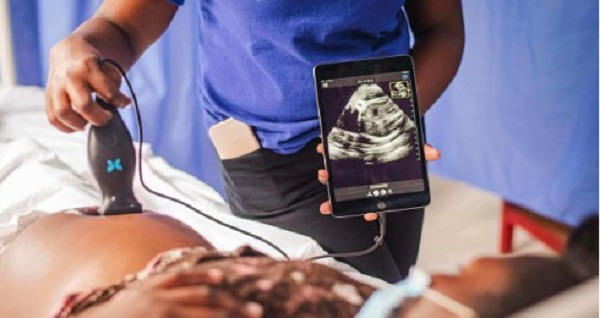
In Ghana, the biggest cause of maternal deaths used to be post-partum hemorrhage (excessive bleeding during childbirth) but a growing number of experts say that hypertension-related issues have taken over. Leading clinical excellence organisations in the world have fingered pre-eclampsia as the leading culprit.
Serious work is today going on around the world to apply AI and other digital technologies to the complex prediction and management of pre-eclampsia and other hypertensive disorders. As the proportion of childbirth deaths associated with hypertension-related deaths in Ghana inch towards 40%, one can be forgiven for expecting a raft of technology-enabled interventions.
It is intriguing that none of Google’s AI-for-health work, some of which is apparently supported by engineers based in Ghana, interfaces with actual maternal mortality programs in the country’s health system. Unlike the case in Kenya, where Google is active in getting ultrasound applications into care delivery settings.
Pupils’ Reading Skills
Google says some of the work feeding into its new Read Along app owes to contributions by personnel based in Accra. Read Along literally aims to reinvent the age-old format of parents and teachers teaching children to read through learning companionship (and the occasional bedtime story).
In India, Google works closely with states like Tamil Nadu and Uttar Pradesh to incorporate Read Along into curricular instruction. Unfortunately, there is no such deep engagement in Ghana. Which is sad considering how more than 90% in testing cohorts of primary school children have been recorded scoring zero on national reading comprehension benchmark tests.
Building a Real Tech Ecosystem that can harness the global-class resources takes work
From the quick scan above of Google’s AI work in Ghana, the pattern is obvious. From a corporate standpoint, Google sees the Ghana location as just one node in a global network for early-stage solution seeking (evident in the fact that nearly 5 months after the inaugural Head left to found a startup, Google is yet to name a substantive replacement).
Google does not have immediate responsibility for infusing new capabilities into the Ghanaian ecosystem. That is the duty and burden of the Ghanaian policy community, which has so far failed to build the necessary linkages across the country’s R&D labs, like Google’s; Ghana’s teeming startup community; and the policy think tanks in order to better connect national priorities with the technological resources emerging in the country.
This author was not surprised to see a lack of growth in numbers of Ghanaian engineers engaged in cutting-edge research at the Google AI center. The publishing output from the Center reviewed often had few Ghanaian co-authors (a rough count suggesting less than 10% in certain corpuses).
Global/multinational tech companies have a clear role to play in augmenting national innovation ecosystems. But they cannot invent a policy medium when none exists.
When leaders only extract PR benefits from the early fruits of “regional hub” strategies but fail in their commitment to drive results, we see episodes like the unfolding Twitter debacle. A year after the Twitter facility was shut down in Accra, following the company’s takeover, former employees have still not been paid their severance. Sadly, the country’s labour regulatory institutions appear impotent to intervene.
Ghana does have what it takes to become a regional tech hub, but it will take more than just hope, enthusiasm, and a knack for PR.
Latest Stories
-
SML/GRA contract: OSP should have released its report by now – Inusah Fuseini
43 mins -
KPMG report exonerates us – SML
51 mins -
Works and Housing Ministry seeks lasting solutions to challenges with stakeholders engagement
1 hour -
President’s statement on GRA-SML contract underlines Fourth Estate’s revelation – MFWA
1 hour -
Our services are one of a kind, not done by NPA – SML insists
1 hour -
We operate legally and collaborate with world-class partners – SML
1 hour -
Director urges parents to protect children from abuse
2 hours -
Imani-Ghana criticises Akufo-Addo for not lauding Fourth Estate’s contribution to social development
2 hours -
Man remanded for allegedly stabbing businessman with broken bottle and screwdriver
2 hours -
Population in Kumasi Central Prison surges to 1800, threefold exceeding capacity
2 hours -
NPP to conduct La Dadekotopon parliamentary primary today
2 hours -
KPMG’s report on GRA and SML deal, government white paper on report and matters arising
2 hours -
I won’t reply to Chris Brown tour criticism – Ayra Star
2 hours -
British Columbia to back off drug decriminalisation project
3 hours -
Veteran commentator Joe Lartey Sr dies at 96
3 hours

